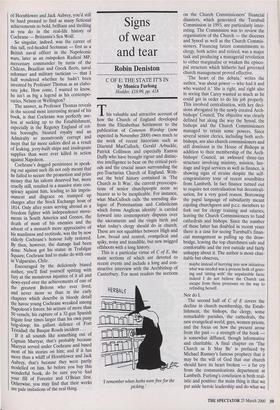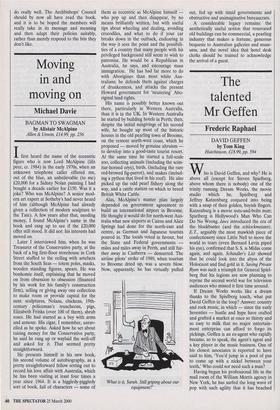Signs of wear and tear
Robin Deniston
C OF E: THE STATE IT'S IN by Monica Furlong Hodder, £18.99, pp. 418 This valuable and attractive account of how the Church of England developed from the Elizabethan Settlement to the publication of Common Worship (now expected in November 2000) owes much to the work of recent historians such as Diarmid MacCulloch, Gerald Arbuckle, Patrick Collinson and especially Eamon Duffy who have brought rigour and distinc- tive intelligence to bear on the critical peri- ods and the crucial issues surrounding the pre-Tractarian Church of England. With- out the brief history contained in 'The Church as It Was', the current preoccupa- tions of senior churchpeople seem so bizarre as to be inexplicable. For instance, what MacCulloch calls 'the unending dia- logue of Protestantism and Catholicism which forms Anglican identity' is carried forward into contemporary disputes over the sacraments and the virgin birth and what today's clergy should do in church. These are not squabbles between High and Low, broad and central, evangelical and spiky, noisy and inaudible, but new twigged offshoots with a long history. This is a particular virtue of C of E, the main sections of which are devoted to recent events and include a long and con- structive interview with the Archbishop of Canterbury. For most readers the sections 'I remember when herbs were free for the picking.' on the Church Commissioners' financial disasters, which generated the Turnbull Commission in 1993, are particularly inter- esting. The Commission was to review the organisation of the Church — the dioceses and Synod as well as the Church Commis- sioners. Financing future commitments to clergy, both active and retired, was a major task and producing a managerial revolution to either marginalise or weaken the episco- pal structure which hitherto had governed church management proved effective.
'The heart of the debate,' writes the author, 'was about power — who had it and who wanted it.' She is right, and right also in seeing that Carey wanted as much as he could get in order to do his job properly. This involved centralisation, with key deci- sions abrogated by the newly created Arch- bishops' Council. The objective was clearly defined but along the way the Synod, the bishops and the Church Commissioners managed to retain some powers. Since several senior clerics, including both arch- bishops, are also church commissioners and still dominant in the House of Bishops in addition to their membership of the Arch- bishops' Council, an awkward three-tier structure involving ministry, mission, her- itage and legal services as well as finance, is showing signs of strains despite the self- congratulatory tone of recent soundbites from Lambeth. In fact finance turned out to require not centralisation but decentrali- sation, for a very good reason. Borrowing the papal language of subsidiarity meant cajoling churchgoers and p.c.c. members to fork out for clergy training and salaries, leaving the Church Commissioners to fund cathedrals and bishops. Since the number of these latter has doubled in recent years there is a case for seeing Turnbull's finan- cial management as pulling up the draw- bridge, leaving the top churchmen safe and comfortable and the rest outside and fairly unhappy about it. The author is more char- itable but observes, maybe instead of hurrying into new initiatives what was needed was a process both of griev- ing and 'sitting with' the unpalatable facts; indeed I do not believe the Church can escape from these processes on the way to refinding herself.
Nor do I.
The second half of C of E covers the decline in church membership, the Estab- lishment, the bishops, the clergy, some remarkable parishes, the cathedrals, the new evangelical world, gays, women priests, and the focus on how the present arose from the past — a strength of the book — is somewhat diffused, though informative and charitable. A final chapter on 'The Church as It May Be' is prefaced by Michael Ramsey's famous prophecy that it may be the will of God that our church should have its heart broken — a far cry from the communications department at Lambeth. Furlong's conclusion is both real- istic and positive: the main thing is that we put aside heroic leadership and do what we do really well. The Archbishops' Council should by now all have read the book, and it is to be hoped the members will really take in its message and meaning and then adapt their policies suitably, rather than merely respond to the bits they don't like.



































































 Previous page
Previous page